The document describes the vision of the National Statistical System (NSS) for 2019-2024, emphasizing the need for timely, reliable, and comprehensive data to facilitate evidence-based policy decisions. NSS aims to modernize and improve the statistical system by leveraging technology, integrating data silos, and enhancing human capital. The goal is to align with global standards, UN principles, and the Sustainable Development Goals (SDGs) to support informed decision-making and good governance in India, with particular attention to transparency, accountability, and data quality. The strategy includes improving data dissemination, building statistical infrastructure, and addressing the challenges of the data revolution.
SOURCE PDF LINK :
Click to access Vision_2024_of_MoSPI.pdf
Click to view full document content
Five Year Vision 2019-2024
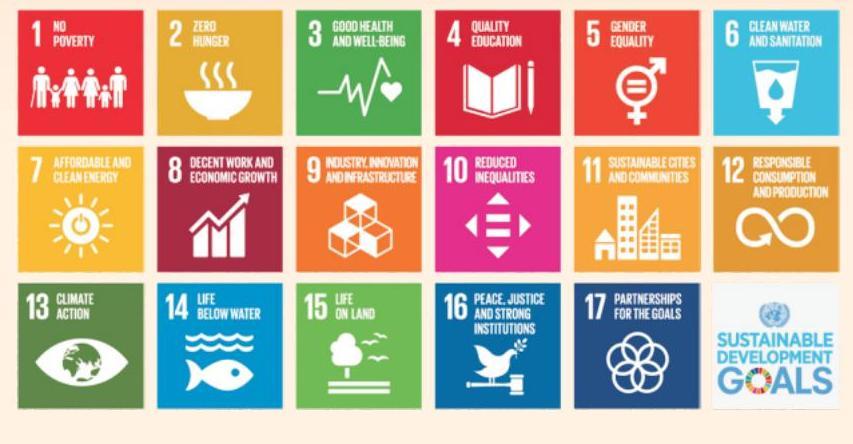
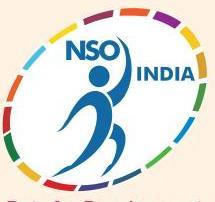
Data for Development
Government of India
Ministry of Statistics and Programme Implementation
Sardar Patel Bhawan,
New Delhi
A. Backdrop for Transformation of National Statistical System ….. 1
B. International Best Practices for National Statistical Systems ….. 3
C. National Statistical System – Vision 2024 ….. 5
D. National Statistical System – Transformational Themes ….. 5
E. National Statistical System – Transformational Strategies ….. 8
F. National Statistical System – Implementation Approach ….. 10
- $\quad$ Strategy I – Strengthening Institutional Framework ….. 11
I.A National Policy on Official Statistics ….. 11
I.B National Statistical Commission Reinforcement ….. 12
I.C Adapting Global Best Practices ….. 12 - $\quad$ Strategy II – Strengthening Technological and Physical Infrastructure ….. 13
II.A Leveraging Technology for Statistical Products, Processes ….. 14
and Services
II.B Leveraging Technology for Statistical Surveys ….. 14
II.C Architectural Strengthening of MoSPI by Leveraging Technology ….. 15
II.D Coordinated integration of registries ….. 16
II.E Physical Infrastructure ….. 17 - $\quad$ Strategy III – Effective Human Capital Management ….. 18
G. Revamped National Statistical System – Expected Outcomes ….. 20
H. Five-Year Strategic Focus and Activities ….. 22
I – Themes, Goals and Key Strategic Activities ….. 22
II – Aggressive Timelines for Vision 2024 ….. 23
III – Details and Timelines for various Strategic Activities ….. 24
Ministry of Statistics and Programme Implementation
Five Year Vision (2019- 2024) Document
Ministry of Statistics and Programme Implementation – Vision 2024
“Strengthen India’s national statistical system to provide real-time inputs for policy and stronger dissemination practices for public.”
Integrated Statistics Approach
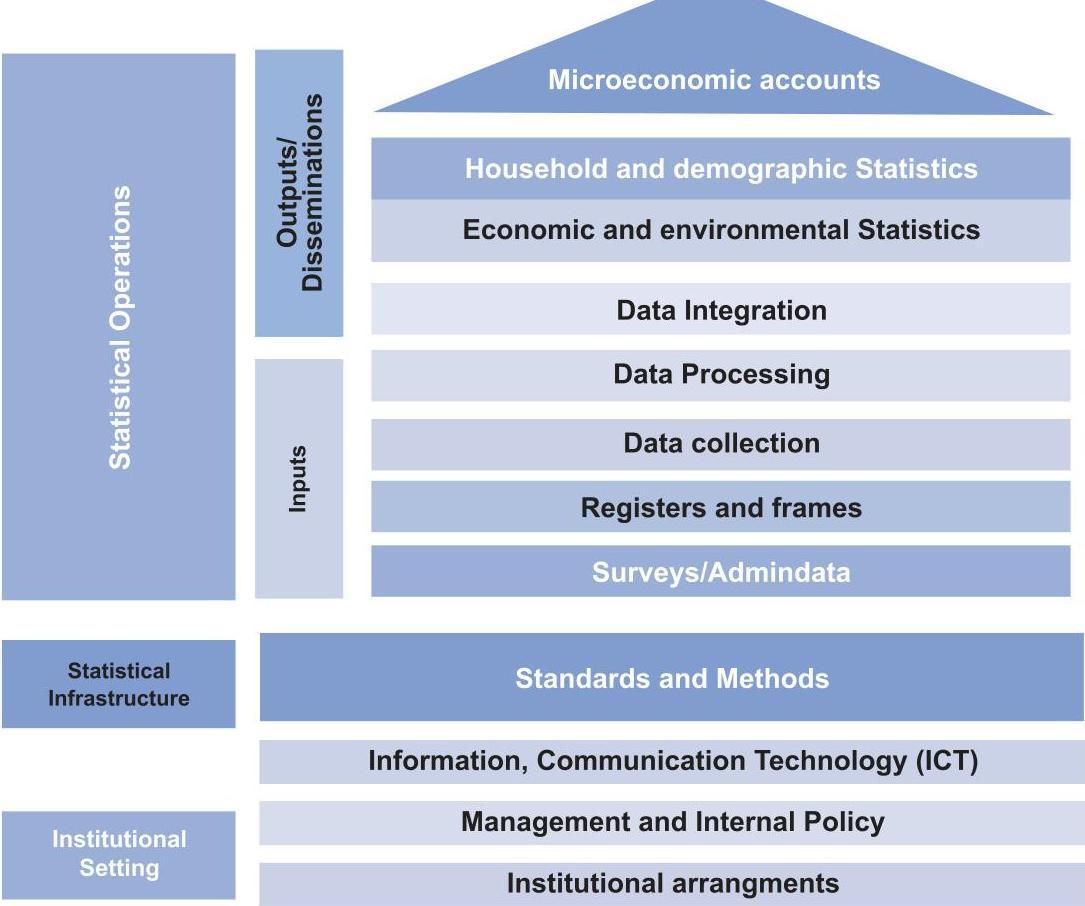
Chapter – I
A. Backdrop for Transformation of National Statistical System
1.1 The primary aim of official statistics system is to provide timely, reliable and comprehensive data in order to facilitate evidence-based decision making towards policy formulation, monitoring, evaluation and recommendations for further improvement. In the Indian context, the official statistics system is laterally decentralized among various Ministries of the Government of India (GOI) at the central level, and vertically decentralized, between the Centre and the States.
1.2 The National Statistical Office (NSO), Ministry of Statistics and Programme Implementation (MoSPI) is the nodal agency for planning and facilitating the integrated development of the national statistical system. It plays a crucial role in responding to the emerging and evolving information/ data needs on a wide range of socio-economicdemographic issues. NSO lays down and maintains norms and standards in the field of official statistics, evolving concepts, definitions, classifications and methodologies of data collection, processing of data and release of results. It also coordinates statistical activities amongst Ministries/Departments of the Government of India as well as with the State Governments to improve the quality of statistical processes and products, identifying gaps in data availability or duplication of statistical work and suggesting remedial measures, and reducing time-lag in bringing out various statistical products. NSO also advises the Central Ministries / Departments and State Governments on statistical matters and activities in laying down statistical standards, conducting sample surveys, censuses and improving administrative statistics. In addition, the Programme Implementation (PI) Wing of MoSPI, reviews the progress of Central Sector Infrastructure Projects costing Rs. 150 crore and above for time and cost overruns and also implements the Member of Parliament Local Area Development Scheme (MPLADS).
1.3 Countries around the world are embarking on significant modernization of their national statistical systems in the face of rapid major technological and socio-economic changes. In line with these changes, official statistical landscape is becoming more complex, expectations of policy makers are increasing exponentially, and the system is challenged to deliver best possible statistics in more efficient and innovative ways. This holds true for National Statistical System of India also. As Official Statistics are produced within the governmental system, these are considered as public goods, and thus it is imperative that they comply with certain basic principles, such as professional independence, impartiality, accountability and transparency about methods of collection and dissemination of statistics. These principles are enshrined in the United Nations Fundamental Principles of Official Statistics, adopted by the UN General Assembly in January, 2014. India adopted these Principles is through a Cabinet Resolution in May, 2016.
1.4 India is at the cusp of a new phase of socio-economic transformation. Increased penetration of digital technologies has brought about transparency and efficiency in the Government functioning and is improving these of living of citizens. As a result, the amount of information available is increasing exponentially and with improved access to the public. Initiatives under Digital India have transformed the e-government landscape with the introduction of world-class digital services. The flow of data from these new services enables the government to harness new and timely data sources for decision support. The central and state governments are rapidly intensifying their efforts to harness these new sources of data. Policy makers need to not only track the progress of various Government programmes but also get a better picture of their impact and outcomes to effect mid-course corrections, which are now becoming possible with the advancements in technology. This has catalysed the dissemination, and consumption of data which are taking place at an unprecedented pace. These developments provide a new opportunity for the national statistical system to align and converge the information flow across varied sources so that an integrated picture emerges for more effective and timely policy interventions.
1.5 In this backdrop of the Industrial Revolution 4.0 driven by the digital data revolution, the National Statistical System needs to be geared up for meeting the contemporary demands of society and policy makers. The statistical products need to become more reliable, easy to understand and be easily accessible. The Government’s initiatives for achieving USD 5 Trillion economy requires real time monitoring of multidimensional parameters of economy. The National Statistical System thus needs to play a continuous and proactive role in providing objective and improved metrics for measuring the development of the economy, society and environment.
1.6 The Indian statistical system is not alone in this transformation journey and it joins many other developing and developed countries in modernising their statistical systems to leverage this opportunity and simultaneously evolve to meet the data demands for the Sustainable Development Goals (SDGs). Fulfilment under SDG commitment also places new demands on the need for quality data and statistics, disaggregated by location, sex, age, income group and other dimensions of development. MoSPI is taking the lead to respond to these demands with timely and robust official statistics for addressing these priorities.
1.7 In the decentralised statistical framework, MoSPI seeks to align its activities to address the high priority information needs of the country for evidence-based policy making and good governance in India while maintaining the credibility of the national statistical system.
B. International Best Practices for National Statistical Systems
2.1 The United Nations and its specialised agencies bring out various guidelines and standards that the National Statistical Offices in member countries can adapt to their specific needs and requirements. In addition, MoSPI has been separately pursuing the ISO:9000 certifications for its statistical processes, and presently, the National Accounts Division, the Price Statistics Division and the Survey Design and Research Division of NSO are ISO:9000 certified. The Ministry has also notified the National Quality Assurance Framework in April, 2018 to be voluntarily administered by statistical offices in India to get a self-assessment score on their quality processes. This is based on the United Nations Quality Assurance Framework. The Sustainable Development Goals adopted by the UN General Assembly provides a vibrant platform for integration of statistical systems both nationally and internationally and will be leveraged appropriately.
2.2 The UN has also brought out the “Guidelines on Integrated Economic Statistics” which guides countries in preparing a set of integrated economic statistics in response to the need for a consistent framework for measuring the country’s economic activity, especially in an increasingly interconnected global economy. Integrated economic statistics provide a consistent and reliable assessment of a country’s economic activity for policy and analytical uses. This assumes all the more significance when countries are required to monitor the progress of achieving the Sustainable Development Goals (SDGs).
2.3 Integrated economic statistics are a set of economic statistics that depict a consistent and coherent picture of economic activities for policy, business and other analytical uses. The integration of economic statistics is about the use of common concepts, definitions, estimation methods and data sources for statistical reconciliation. In today’s global context, the users of the statistical services ask for more and better statistics, and the statistical service providers need to be proactive in satisfying the increasing user needs for integrated economic data. In addition, a number of recent emerging initiatives on the measurement of sustainability, social progress and well-being have raised the need for integrated and coherent official statistics to shed light on those complex issues, and therefore pose challenges to statistical offices to produce integrated economic, environmental and socio-demographic statistics. The development of such integrated and multidimensional statistics requires developing the capacity to integrate the production of relevant statistics.
2.4 The motivation for integrated economic statistics comes from the benefits that these statistics provide for coordinated national and global policy initiatives in an increasingly interconnected world. The motivation is relevant for all countries, independent of their level of development of statistical systems and national economies.
The integration is achievable for small and comprehensive national economic data sets and can be progressively introduced into the national statistical system.
2.5 The approach for transformation in MoSPI would be on the lines of the broad recommendations of the UN ECE High-level Group for the Modernisation of Official Statistics (MOS), by adapting the framework to the Indian context. The framework includes the following components:
a) Generic Statistical Business Process Model (GSBPM) – This model describes the core business processes undertaken by statistical organizations to produce statistical outputs. It can help statistical organisations to find common processes across organisations to reduce inefficiency and redundancy.
b) Generic Statistical Information Model (GSIM) – This model describes the core pieces of information needed by statistical organizations to produce statistical outputs. It gives a common language to describe the information that flows in and out of GSBPM processes.
c) Common Statistical Production Architecture (CSPA) – CSPA provides an overarching framework for statistical organisations to more easily share and reuse methods, statistical models, implemented methods and implemented services.
d) Generic Activity Model for Statistical Organisations (GAMSO) – This model describes the activities that take place within a typical statistical organization. It extends and complements GSBPM by adding overarching processes needed to support statistical production.
The transformational framework, when implemented, will facilitate soft integration of data silos existing in the system through meta-data mapping across systems including soft integration of statistical registries.
2.6 Critical pillars to this transformation are not only the technological interventions but also the management of human capital for the statistical framework being put in place. Innovative techniques will be evolved for exploiting new data sources and will require involvement of research and other institutions so that new ideas can be crowd sourced, incubated and developed for use in the national statistical system.
C.The National Statistical System – Vision 2024
- The Vision 2024 for the National Statistical System, spearheaded by MoSPI, derives from the fact that official statistics is a public good and an essential part of development infrastructure. MoSPI will play a crucial role in coordinating and harmonizing the metadata for statistical products available in the country using technological interventions. The Vision 2024 has been formulated to provide a holistic, coherent and comprehensive framework for improving the national statistical system, thereby delivering official statistics in the country in a reliable and sustainable manner. It also aims to bridge the identified data gaps by providing data on a real time basis via userfriendly platforms to Government and other stakeholders with extensive use of technology for the statistical products and processes. The reform measures will address the institutional, organizational and technical challenges being faced in the present system. The five-year vision of MoSPI is envisaged as:
Ministry of Statistics and Programme Implementation – Vision 2024
“Strengthen India’s national statistical system to provide real-time inputs for policy and stronger dissemination practices for public.”
D. National Statistical System – Transformational Themes
4.1 National statistical system is operating in a dynamic environment with new opportunities for and challenges in accessing and integrating vast amount of data becoming available. Real time access to data to monitor the performance of economy by the policy makers is of paramount importance to identify early signs for triggering midcourse corrections and facilitate identification of optimal ways and means to respond. The national statistical system is therefore required to keep pace with the rapidly changing nature of economy and society. A credible statistical system requires statistical production processes that can produce high quality and timely statistics that meet the needs of varied users.
4.2 Equally important, official statistics need to produce statistics with a high-level of professional independence. Countries that are undergoing transformation have responded by (a) changing policy, legal and governance arrangements that shaped their statistical systems; and (b) modernizing the operations of their statistical offices and adjusting the type of statistical outputs produced to meet the needs of their rapidly changing economies.
4.3 Government is the custodian of vast repository of administrative, survey, institutional and transaction data. Such data is termed as ‘Administrative Statistics’ which is essentially data collected by Government at different levels through its instrumentalities, largely as a by-product of administering specific legislation,
ike MCA, GSTN etc. Administrative data collected by various Government agencies are not being optimally utilized since much of these datasets are dispersed across different Government institutions and agencies. These agencies also maintain multiple registries for collection and compilation of data in silos. For each indicator of social welfare, responsibility to gather data lies with the corresponding Central or State Government institution and each has defined its own Metadata standards, where Metadata is structured minimal information that describes, explains, locates or otherwise makes it easier to retrieve, use or manage an information resource. Some of the e-governance projects do follow the Metadata and Data Standards (MDDS) coordinated by Ministry of Electronics and Information Technology (MeitY). However, in general, data gathered by a Government agency is maintained separately from that gathered by another. Integrating the information across the data sets will be extremely useful for policy makers to monitor various interventions and programmes on a real time basis for effecting mid-course corrections. Such integrated data is more valuable than isolated data sets being maintained by various agencies.
4.4 These watertight data sets create a large amount of duplicate data, have an increased pressure on virtual data storage and potentially clog the digital ecosystem. There exists no common database of registries across beneficiary schemes at the national level to facilitate the policy makers about the actual number of beneficiaries. Similarly, data relating to financial sector, establishment and enterprises are also unconnected and dispersed across the Government Institutions.
4.5 Integration of data existing in silos is an imperative need for the evolving socioeconomic landscape of the country. Enabling sharing of information and access to data sets would improve the implementation of Government welfare schemes, empower people to make better decisions and democratize an important public good. Since databases have slowly become on-line within the Central and State Governments, they offer a new opportunity to build a sound national data infrastructure for future governance. This will also enable interoperability of the data sets in digital and portable formats.
4.6 In order to embrace new opportunities of the data revolution, effective R\&D and innovation are essential elements in every part of the statistical system. During the next five years, MoSPI aims to develop and implement pioneering ways to respond to the unmet statistical needs using innovative, efficient and effective methods. MoSPI will facilitate greater use and linkage usage of administrative data in the day to day functioning of Government. Using new technologies and identifying and exploiting methods, MoSPI through its concerted interaction with stakeholders intends to achieve a major change in the sharing of data within and beyond Government for statistical purposes. Similarly, access to data to public will be made in a user-friendly manner.
Government for statistical purposes. Similarly, access to data to public will be made in a user-friendly manner.
4.7 MoSPI, as the nodal agency for the national statistical system, appreciates the need to integrate these data silos and their analytics, management and dissemination by optimally utilizing digital technologies. Since the data systems have been in operation for a significant time, it is not feasible for retro-fitting metadata standards onto running systems. The approach would be to have a soft mapping of the metadata and facilitate a Data-Lake architecture that will provide useful insights to various aspects of the Indian economy, which may not be feasible through manual systems.
4.8 Strengthening data dissemination requires an emphasis on both timely dissemination of data assets in user-friendly formats and improvement in communication of statistics. MoSPI is already giving access to unit level data along with relevant metadata of its various socio-economic surveys. MoSPI also plans to strengthen its communication mechanism with the stakeholders and build expertise in strategic communication and brand management, media relations, content creation, website management, stakeholder engagement, social media, digital media and data visualization. Communication and user engagement will be improved by greater use of info graphics and videos, and dynamic visualizations to highlight insightful trends and concepts relating to commonly used indicators. MoSPI will explore innovative ways of making data, statistics and analysis more accessible, easier to understand and support accurate and meaningful interpretation. Statistical products of MoSPI will be made available to users in open format for re-use while protecting the confidentiality of personal information.
4.9 In the above backdrop, over the next five years, MoSPI will implement wideranging reforms of statistical products and processes to realize its vision. This reform process will focus on the following broad themes:
Theme I: Strengthening statistical infrastructure for real-time monitoring of the economy.
Theme II: Integrating data and registries, existing in silos in various Ministries, into the National Statistical System through an Integrated Information Portal by developing data sharing protocols and use of technology
Theme III: Strengthening the monitoring of large infrastructure projects
4.10 The themes for reforms will be based on the UN Generic Statistical Business Process Model (GSBPM), Generic Statistical Information Model (GSIM), Common Statistical Production Architecture (CSPA) and the Generic Activity Model for Statistical Organisations (GAMSO), after adaptation to the Indian context (para2.5 above refers).
E. National Statistical System – Transformational Strategies
5.1 The statistical reform initiatives being undertaken by MoSPI will be achieved through a Mission Mode approach with aggressive timelines for repositioning itself to be at the vanguard for providing data for Government policies and interventions. MoSPI has identified key drivers for reinvigorating the National Statistical System for data driven interventions for measuring the progress of the Government’s goal of achieving USD 5 trillion economy by 2024 and with enhanced ease of living. These drivers are based on the following strategies
Strategy I: Strengthening Institutional Framework
Strategy II: Strengthening Technological and Physical Infrastructure
Strategy III: Effective Human Capital Management
5.2 The motivation for transformation of the statistical products and processes will be the UN Generic Statistical Business Process Model (GSBPM), illustrated in the Figure There are more than 50 developing and developed countries that have adopted this model in conjunction with other transformational models to improve efficiency and relevance in national statistical operations.
Figure 5.1: UN Generic Statistical Business Process Model (GSBPM)
Overarching Process
| Specify needs | Design | Build | Collect | Process | Analyse | Disseminate | Evaluate |
|---|---|---|---|---|---|---|---|
| 1.1 Identify needs |
2.1 Design outputs |
Reuse or build collection instruments | 4.1 Create frame and select sample |
5.1 Integrate data |
6.1 Prepare draft outputs |
7.1 Update output systems |
8.1 Gather evaluation inputs |
| 1.2 Consult and confirm needs |
2.2 Design variable descriptions |
Reuse or build processing and analysis components | 4.2 Set up collection |
5.2 Classify and code |
6.2 Validate outputs |
7.1 Produce dissemination products |
8.2 Conduct evaluation |
| 1.3 Establish output objectives |
2.3 Design collections |
Reuse or build dissemination components | 4.3 Run collection |
5.3 Review and validate |
6.3 Interpret and explain outputs |
7.3 Manage release of dissemination products |
8.3 Agree an action plan |
| 1.4 Identify concepts |
2.4 Design frame and sample |
Configured workflow | 4.4 Finalise collection |
Edit and impute | Apply disclosure control | Promote dissemination products | |
| 1.5 Check data availability |
2.5 Design processing and analysis |
Test production systems | 5.5 Derive new variables and units |
6.5 Finalise outputs |
7.5 Manage user support |
||
| 1.6 Prepare and submit business case |
2.6 Design production system and workflow |
Test Statistical business process | 5.6 Calculate weights |
||||
| 3.7 finalise production systems |
5.7 Calculate aggregates |
||||||
| 5.8 Finalise data files |
5.3 The above GSBPM model can be adapted to the Indian context to transform the national statistical landscape for real-time monitoring of the Indian economy, as illustrated in Figure 5.2 below. It needs to be appreciated that the Ministry has already taken several steps under the GSBPM Model, albeit in an isolated manner and confined to Division specific activities. The effort now would be to bring the transformational processes in line with the global best practices using this model as a framework.
Figure 5.2: Integrated Statistics for Real Time Monitoring of the Indian Economy
Real-Time of Monitoring of Economy
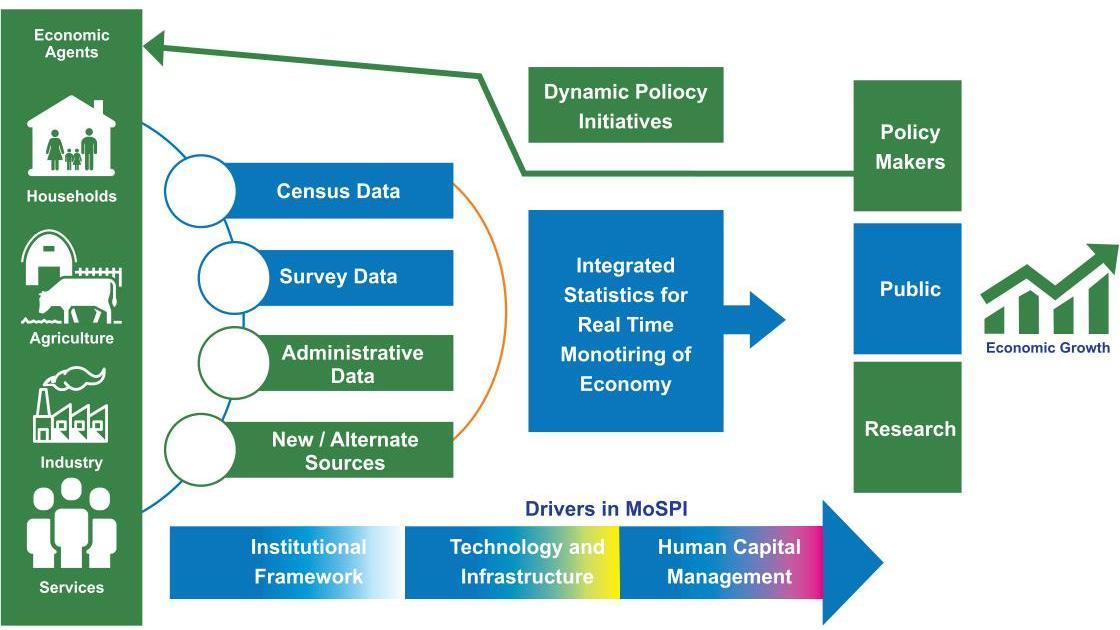
5.4 It may be seen that the thrust of the transformation is not merely focussed on improved statistical operations in census, surveys and administrative data, which are traditional sources of statistical information. In fact, new/alternate data sources emanating from Big Data have potential to come with lower cost and can lead to more timely and granular statistics. However, there are still issues that hinder exploiting such data, such as potential of bias, coverage, uncertainty about accuracy of user-generated contents, difficulty of coordination with data holders, privacy regulations and social license. These need to be addressed through an effective policy framework.
F: National Statistical System – Implementation Approach
6.1 The implementation framework to achieve Vision 2024 of MoSPI will involve mobilizing critical drivers of transformation including institutional, legal and policy framework, IT strategy, Human Capital Management, creating quality consciousness, innovation and R\&D, and enhanced user engagement with appropriate dissemination strategy.
Strategy I:Strengthening Institutional Framework
6.2 Several initiatives had been taken in the past by MoSPI for reforming the national statistical system including those in pursuance of the recommendations of National Statistical Commission headed by Dr. C. Rangarajan (2000-2001). These, inter-alia, include setting up of National Statistical Commission (NSC) as an apex advisory body on statistical matters, enacting Collection of Statistics Act, 2008, adopting international standards of data collection and dissemination in the field of national accounts, price statistics, industrial statistics, designing National Indicator Framework(NIF) for monitoring the Sustainable Development Goals (SDGs), monitoring of large scale central sector infrastructure projects, providing technical support to States/ UTs in evolving their own statistical products, financial assistance to States/UTs for improving their statistical systems, capacity building in official statistics etc. India has also adopted United Nations Fundamental Principles of Official Statistics (UNFPOS) recognising official statistics as public goods which needs to comply with certain basic principles, such as professional independence, impartiality, accountability and transparency about methods of collection, compilation and dissemination.
6.3 In spite of continuous efforts made by the statistical agencies in India to improve their systems, certain systemic deficiencies persist like the existence of gaps in availability of required information; delays in publication of results; periodic revision of released indicators; discrepancies between official statistics from different sources; transparency in statistical operations; availability of trained manpower and financial resources. These deficiencies have implications on the credibility of official statistics, particularly in a decentralised system. The existing institutional arrangements and legal framework need to be reinforced to cope with the increased requirements of data and for monitoring the health of the economy on a real time basis. In this direction, MoSPI aims to further strengthen the official statistical system by taking transformative measures in the existing institutional, legal and policy framework to ensure that access to reliable official statistics is equitable and free, and promotes the widest possible use of official statistics for the economic development agenda.
I.A National Policy on Official Statistics
6.4 The Government of India adopted UN Fundamental Principles of Official Statistics in 2016 with a view to promote good practices and professional ethics in production and dissemination of Official Statistics in the country. These principles are expected to benefit decision makers, statisticians, data providers and users in various ways and instil public trust in Official Statistical System and honour citizens’ and
users’ entitlement of Official Statistics as ‘public good’. In furtherance of these principles, MoSPI is formulating a National Policy on Official Statistics (NPOS) which will act as the guiding principle towards establishing an improved Statistical System to bring in more synergy amongst Central and State Governments in statistical matters. This will focus on providing timely and credible social and economic data for evidence-based decisionmaking, promoting research, and fostering an ecosystem for informed debate on various social and economic issues affecting people’s lives.
I. 8 National Statistical Commission Reinforcement
6.5 In pursuance of the recommendations of the National Statistical Commission under the Chairmanship of Dr. C. Rangarajan in 2001, the Government, vide Resolution dated1st June 2005, constituted a National Statistical Commission (NSC) with a mandate to improve the statistical system and evolve a suitable statute for the purpose. The NSC was to evolve a statute in light of its own operational experience and also identify core statistics (statistics of national importance) where the resources of the government could be prioritised. Though the NSC, has since its inception, made a number of recommendations to improve the statistical system through its Annual Reports, yet, major structural changes remained mostly unexamined. The mandate of the NSC is far reaching and for it to perform its functions effectively, it needs to be suitably reinforced with appropriate professional autonomy in making implementable recommendations. At a time when the official statistical system is undergoing a paradigm shift, this assumes great significance. A similar transformation of the functioning of the national statistical system also needs to be undertaken, including that in MoSPI.
I.C Adapting Global Best Practices
6.6 MoSPI will leverage the framework of the UN Generic Statistical Business Process Model (GSBPM) (Figure 5.1) in statistical operations and services in the following areas:
a) To define and describe statistical processes in a coherent and comprehendible manner;
b) To compare and benchmark processes within and between statistical agencies or organisations;
c) To make better decisions on statistical production systems and organisation of available resources.
6.7 MoSPI recognises that the GSBPM is not a linear model and the sub-processes need not follow a strict order. Thus, while adapting the GSBPM, it will be considered to be a process matrix, through which there are many possible alternative paths, including iterative loops within and between phases, that will be identified and prioritised. The GSBPM will involve planning, implementation and assessment of the various components.
6.8 In brief, the major steps to be undertaken under Strategy I are:
a) Drafting and finalising a National Policy on Official Statistics for furthering the UN Fundamental Principles of Official Statistics.
b) Strengthening the National Statistical Commission through wider consultation and active involvement of central and state governments, industry, academia and civil society.
c) Establishing a statistical framework for operationalising the Generic Statistical Business Process Model (GSBPM) in statistical operations and services. This will involve integration of statistical processes, statistical datasets and convergence of multi-disciplinary concepts and definitions.
d) Establishing an agile institutional framework in MoSPI that encourages innovation, incubation and development of new ideas and processes. This requires internal restructuring within the Ministry so that various Divisions become more cohesive and agile through process and product reforms.
e) Establishing strategic partnership and synergies with institutes of excellence in statistical operations and leveraging best practices for continuous improvement in data quality, especially for the SDGs.
Strategy II:Strengthening Technological and Physical Infrastructure
7.1 Reforms in the statistical system are inextricably linked with the adoption of latest technologies in statistical processes and products to ensure responsiveness of the system to the needs of the economy. MoSPI has recently taken up several IT initiatives at various levels for improving data-gathering, storing, processing and dissemination of statistical information. However, a lot more remains to be done, especially for exploiting and embracing technological advancements, and MoSPI is committed to undertake these during the next five years.
7.2 The National Statistical System continues to grapple with legacy systems, data silos and a shortage of capability in delivering digital transformation. As the nodal Ministry for statistical activities, the immediate priority is to make available socio-economic data that are spread across different Government Agencies at one place by integrating these data sets for real time monitoring and now casting of macroeconomic indicators. This will necessarily entail evolving data sharing protocols and standards amongst the agencies. The broad principles governing the IT interventions of MoSPI are anchored in the Generic Statistical Information Model (GSIM), which describes the information objects and flows within the statistical business process and the Common Statistical Production Architecture (CSPA), which will make it easier for each organization to standardize and combine the components of statistical production, regardless of where the statistical services are undertaken. The protocols for data exchange will use SDMX and Data Documentation Initiative (DDI) as necessary across various data systems.
II.A Leveraging Technology for Statistical Products, Processes and Services
7.3 MoSPI is in the process of developing a National Integrated Information Portal (NIIP) for official statistics in the country. NIIP will be the state-of-the-art digital repository of all official statistics with homogenized meta-data. NIIP will provide high end platform for data analytics and interpretation of socio-economic data to Central Ministries/State Governments and other stakeholders, including general public. This will also have a dashboard for socio-economic indicators for real time monitoring and now-casting of macro-economic indicators.
7.4 The development of NIIP comprises three phases. In first phase, all statistical activities of MoSPI will be integrated while in second phase, the key data sets available with the Central Ministries/Departments/Agencies will be integrated using technological solutions for seamless flow of sharing of data. In the third phase, data available in State Government Agencies will be on-boarded on NIIP. In the final phase, NIIP is to be made fully operational to monitor the health and progress of the economy on a real time basis and to suggest leads for sector specific interventions based upon data analytics. The NIIP will facilitate the flow of information for the SDGs and also for quicker generation of key macroeconomic indicators.
II.B Leveraging Technology for Statistical Surveys
7.5 The socio-economic surveys conducted by the MoSPI provide a panoptic insight of socio-economic conditions in the economy. While the demand for such surveys on a regular basis to bridge the data gaps on various sectors of economy has witnessed an upward trend, this also puts increased pressure on the existing systems to deliver the
results of the surveys quickly and without compromising on data quality. MoSPI has been traditionally using paper schedules to collect information from the field – households and establishments. The paper-based survey method mostly entailstedious data processing, data scrutiny, etc. which has a cascading impact on the timely release of the results. The Ministry had first introduced Computer Aided Personal Interview (CAPI) module for ongoing Periodic Labour Force Survey. The CAPI software platform enables seamless transition from Paper Aided Personal Interview (PAPI) system in an intelligent, simple and efficient manner using IT solutions. It also offers effective management of survey operations through its set of survey management tools such as management of individual interviews (cases), data transfer and data export of interviews (cases) into a standard format. The Ministry intends to develop an in-house CAPI module for all its socioeconomic household and establishment surveys. This will enable quick data capturing in digital mode at the field level, thereby significantly reduce time lag and facilitate better monitoring of the field operations through analysis of para data
II.C Architectural Strengthening of MoSPI by Leveraging Technology
7.6 The general structure and layers for these reforms are illustrated in Figure 7.1 below, summarises the transformational approach using the global models and guidelines evolved by the United Nations.
Figure 7.1: Business and Technological Integration in MoSPI
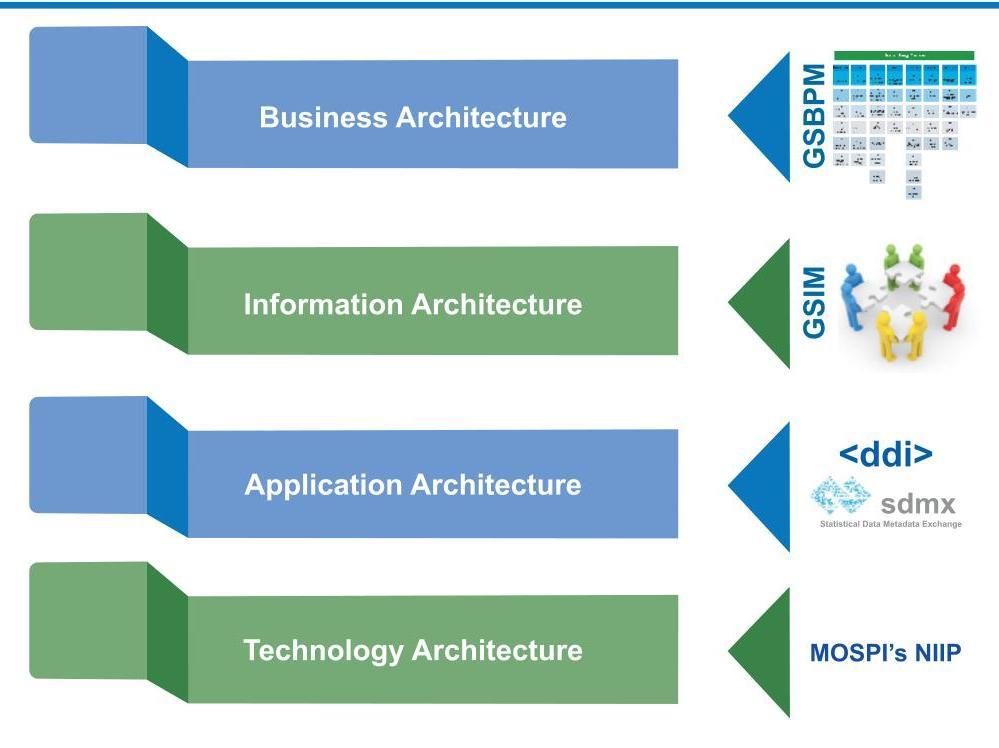
II.D Coordinated integration of registries
7.7 As brought out earlier, various governmental and statistical agencies create registries for their administrative requirements and monitoring of schemes. There is a need to facilitate the flow of information across such registries for production of integrated statistics. A conceptual model is given in Figure 7.2
Figure 7.2: Coordinated Information Flow across Registries
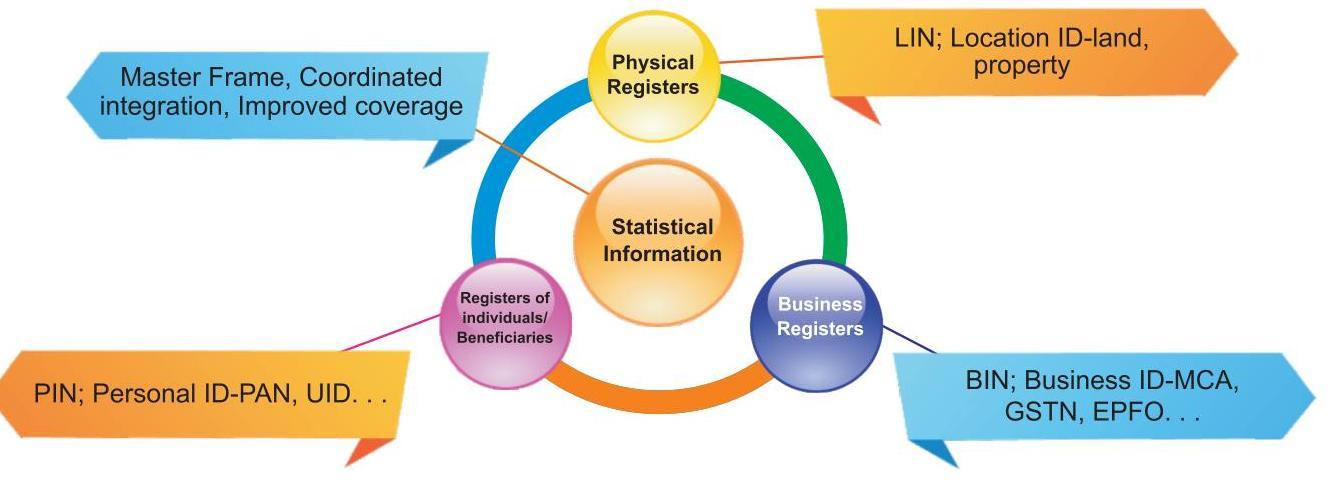
7.8 Efforts are on by various agencies for improving the existing registries as also creation of new ones that do not exist. For instance, there are several platforms available for the Registry of Individual Persons like the Unique Identification (Aadhaar), the Permanent Account Number (PAN), etc. and efforts are on for integration and linking the two sets. Similarly, efforts are on by the Survey of India for mapping the geographic terrain using drones and high resolution imagery. There is a need to holistically examine information across such registries for providing useful insights for effective policy interventions. This will require intense coordination amongst governmental and nongovernmental agencies to facilitate the flow of information without compromising on confidentiality and data privacy concerns. This soft integration will be operationalised through the NIIP architecture.
Use case – National Statistical Business Register
7.9 MoSPI is conducting 7th Economic Census which lists out all establishments/ enterprises in the country. The Economic Census will provide a framework for dynamic National Business Register which can be updated using the data available with the MCA, GSTN, ESIC, EPFO etc. Many State Governments have initiated the process of preparing their own business register by integrating all their establishments. For instance,
Rajasthan has been successful in developing business register with unique Business Registration Number (BRN) thereby integrating business establishments in that state. These successful use cases can be up-scaled at the national level. The National Statistical Business Register generated through Economic Census can provide a platform for integration of databases of business establishments/ enterprises in the country. To sum up, creation of a common database of individuals who are availing the benefits of the Government welfare schemes as well as of the establishments and enterprises will go a long way in improving efficiency of the system.
7.10 The Ministry also reviews the progress of implementation of large central sector infrastructure projects costing Rs. 150 crore or more for time and cost overruns. Presently there are over 1600 projects that are being monitored on a monthly basis. The monitoring needs to improve so that the Government can identify projects that have potential for quick completion and prioritise investments accordingly.
II.E Physical Infrastructure
7.11 Presently, MoSPI is functioning from six different locations scattered across Delhi. Majority of MoSPI’s important statistical activities such as bringing out GDP, IIP, CPI etc. require constant co-ordination and interaction between Line Ministries, State Governments and within the Ministry, which is becoming increasingly difficult in the present set up and has had adverse impact on the operational issues and functioning of the Ministry. MoSPI has taken initial steps to procure an integrated building complex for intensifying various statistical and coordination activities of the Ministry and for creating conducive working environment with enhanced efficiency and synergy.
7.12 The specific activities to be undertaken under this strategy include:
a) Inter-Ministerial Coordination Committee for integration of information systems.
b) Development of the National Integrated Information Portal Project as the underlying technology initiative.
c) Development of a Generalised Survey Solution for the National Sample Surveys.
d) Procurement of office infrastructure for MoSPI.
Strategy III: Effective Human Capital Management
8.1 The demand for data poses significant challenges to the National Statistical System in terms of capacity building. While data revolution offers tremendous opportunities for producing more and better data quickly, however, in order to reap the benefits of changes in technology, a capacity enhancement has to take place simultaneously. The statistical system at the central and state government level is facing an acute shortage of manpower at various levels and this needs to be augmented on priority, both in terms of numbers as well as skill sets, so that the existing and envisaged role can be performed. With the advent of tools such as Big Data Analytics, Machine Learning etc. for developing capabilities of existing manpower resources needs to be addressed through a comprehensive Human Capital Management strategy.
8.2 It is the people who transform systems. Staff working in statistical units of Governments needs to develop new skill sets that enable them to harness new technologies, apply complicated statistical methodologies, understand complex policy issues, and effectively communicate and negotiate. Besides comprehensive capacity development programmes, part of technical capacity building can be fulfilled through regular and structured user-producer dialogues.
8.3 In so far as training of existing statistical manpower is concerned, a key role is being played by the dedicated National Statistical Systems Training Academy (NSSTA), Greater Noida. The academy’s role is primarily confined to induction training programmes for statistical cadres of central government and in-service short-term refresher courses for the statistical personnel of central and state governments. Some training capacities in official statistics also exist in a few States, but these are mostly inadequate.
8.4 The demands for more nation-wide surveys is increasing and the National Sample Survey (NSS) is now required to undertake 4-5 new surveys each year when it was conventionally doing only one survey each year. As regular staff cannot be increased overnight to undertake the increased workload of new surveys, it requires adopting a strategy of outsourcing of field work. Accordingly, the NSS employed manpower agencies to provide survey enumerators which were then trained in-house before being deployed to the field. The field monitoring and supervision was undertaken by the regular statistical manpower. Technology is also being used now for the data collection on electronic devices/tablets to facilitate quicker data processing. These interventions are being done at the national level, however, state governments do not have that flexibility to engage statistical manpower on contractual basis, as a result of which their state surveys are impacted.
8.5 While conducting the Economic Census of all establishments during 2019, MoSPI has collaborated with the Common Service Centres of Ministry of Electronics and IT for undertaking the field work. This required intense training and capacity building before the field operations could commence and it was possible to adopt this approach as the information being sought is limited. For a detailed socio-economic survey, more qualified and trained manpower resources would be required. Thus, a hybrid approach would need to be adopted for undertaking additional surveys using a combination of regular and contractual manpower resources.
8.6 To meet the current and ever-growing needs of a modern and decentralized statistical system, human capital management needs to be strong and dynamic. MoSPI plans to undertake a comprehensive review of human capital management practices for the national statistical system. This review, among other things will cover assessment of HR capacities, assessing future requirements, conducting a gap analysis and suggesting strategies for closing these gaps. A roadmap and an action plan will be evolved to strengthen the human development activities in the short-run as well as in the long-run. The data revolution for sustainable development has also triggered interest in the use of big data, machine learning, and artificial intelligence for official statistics. Recognizing its potential, countries around the globe have already started leveraging these emerging analytical tools in their statistical system to generate real time information products. In order to utilise these modern analytical tools in the official statistical system, there is a need to inject requisite skill set in the existing human resources. Therefore, one of the thrust areas of reform activities of MoSPI during the next five years is to augment the capacity and skills of human resources to respond to the changing demands.
8.7 The NSSTA will be the focal point for Human Capital Management and will be developed as a Centre of Excellence in official statistics in the country. This will require expanding the footprint of NSSTA in regional areas for meeting its enhanced role, envisioned in Vision 2024. It will also collaborate with international agencies for training in global best practices and prepare professionals with analytical skills using Big Data, Artificial Intelligence and other emerging technologies. NSSTA will also create a pool of professionals for providing consultancy/research/innovative services in the official statistics. It will formulate appropriate course curriculum and e-learning modules on official statistics to be made mandatory at undergraduate level in all institutions. The feasibility of introducing administrative statistics as a topic in the training curriculum of various training institutes/ academies imparting training to service personnel in the Civil Services will be examined for implementation.
8.8 MoSPI is also interacting with the Ministry of Skill Development and Entrepreneurship (MSDE) to evolve course content for survey enumerators, field inspection, supervisors and data quality personnel. The aim is to open and develop the market for such survey enumerators that can be hired by professional agencies and
manpower consultants for undertaking surveys by central and state governments. Modalities for course content, assessment, evaluation and certification are being worked out using the Sector Skill Council framework evolved under the National Skill Development Corporation setup.
8.9 The specific activities to be undertaken under this strategy includes the following:
a) Large scale capacity building of statistical personnel on contemporary statistical techniques and methodologies including Big Data Analytics, Artificial Intelligence and Machine Learning.
b) Enhancing capacities in the National Statistical Systems Training Academy for training of statistical manpower including exposure to international best practices.
c) Assessing the statistical capacities in central and state governments for augmentation and enhancement.
d) Cadre review of Indian Statistical Service and Subordinate Statistical Service to augment statistical capacities at the central government level.
e) Finalising and rolling out capacity building programmes for survey enumerators to be run by the MSDE skill development ecosystem to facilitate and enhance national and state level survey capacities.
f) Empanelment of manpower agencies with skilled survey enumerators to be used by central and state government statistical institutions.
G. Revamped National Statistical System – Expected Outcomes
9.1 The broad outcomes of the revamped system include the following:
a) Improved statistical processes and products that are
- Relevant
- Accurate
- Reliable
- Timely / Punctual
- Accessible
- Coherent
- Comparable – spatially, temporally and internationally
b) Better data integration with minimal redundancies
c) Multi-disciplinary statistical products
d) Partnerships and intense collaboration among stakeholders of statistical products
e) Improved user-producer discussion and dissemination forum.
This will be facilitated by the transformational processes proposed in the Vision Document and illustrated in the Figure 9.1 below.
Figure 9.1: Architectural Framework for Integrated Statistics Approach
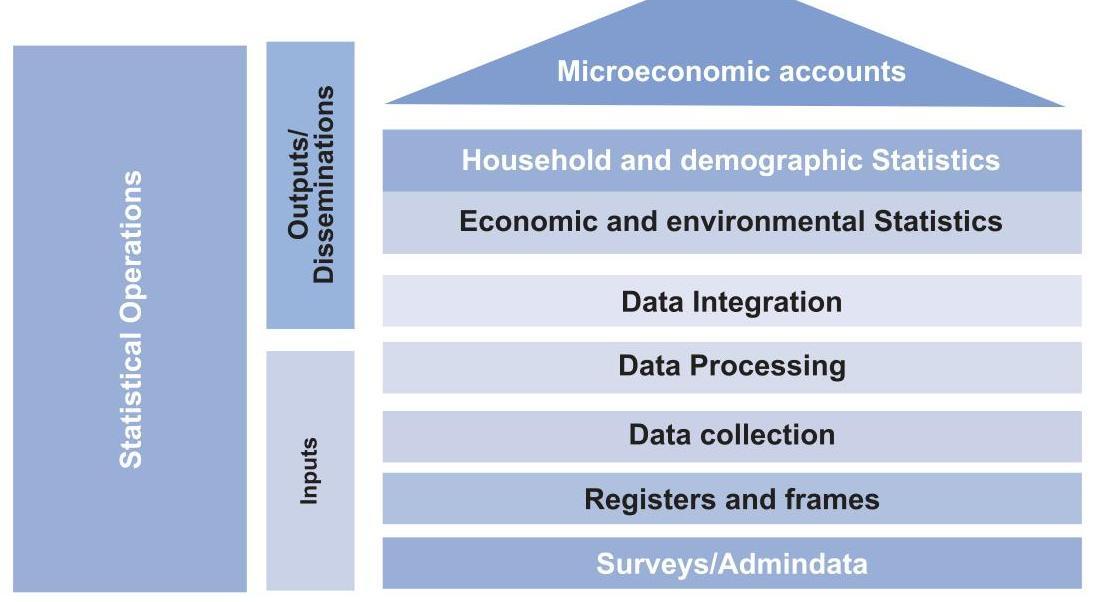
Statistical
Infrastructure
Institutional
Setting
Standards and Methods
Information, Communication Technology (ICT)
Management and Internal Policy
Institutional arrangements
H. Five Year Strategic Focus And Activities
H.I Themes, Goals and Key Strategic Activities
| Themes | Goals | Strategic Activities |
|---|---|---|
| 1. Strengthening Institutional Framework | 1.1 Establish an effective legal and policy statistical framework | 1.1.1 National Policy on Official Statistics will be formulated and notified giving the role and responsibilities of MoSPI to spearhead the reform processes in the national statistical system. 1.1.2 A bill on strengthening the National Statistical Commission (NSC) will be drafted and introduced in Parliament with a view to establish NSC as a professionally autonomous entity for providing strategic direction and guidance to the national statistical system and for data quality assurance. 1.1.3 Customise/ Develop a Quality Assurance Framework for statistical products and processes. 1.1.4 Evolve a framework for progressively enhancing the use of administrative statistics across agencies. 1.1.5 Establish institutional mechanism for facilitating data integration. 1.1.6 Implement Code of Ethics for members of various committees of MoSPI to ensure professional ethics while dealing with data which are not in the public domain. 1.1.7 Strengthen the framework for monitoring of SDGs. 1.1.8 Strengthening data dissemination structure and user engagement through: a. Advance Release Calendar for key statistical products b. Development of media policy/ plan of MoSPI for dissemination and user engagement c. Regular data producer-user conferences and user feedback mechanisms |
| 1.2 Strengthen statistical processes and procedures, and develop new statistical products | 1.2.1 Assess existing statistical products/ processes w.r.t. the Quality Assurance Framework for improvement. 1.2.2 Prepare a compendium of data sets and registries of Central Ministries and State Governments, their metadata and legislative provisions. 1.2.3 Develop statistical data and metadata exchange protocol amongst Central and State Governments and other agencies including international organizations. 1.2.4 Bring out Fact sheet of Indian Economy for regular monitoring of the economy. 1.2.5 Develop National Statistical Business Register. |
H.I Themes, Goals and Key Strategic Activities
| Themes | Goals | Strategic Activities |
|---|---|---|
| 2. Strengthening Technological and Physical Infrastructure of statistical system | 2.1 Develop an integrated technology platform for official statistics | 2.1.1 Develop National Integrated Information Portal/ Data Warehouse for official statistics. |
| 2.1.2 Develop and implement IT based Generalised Survey Solutions (GSS) for all socio-economic household and establishment surveys | ||
| 2.2 Strengthen the monitoring of infrastructure projects | 2.2.1 Revamp the existing mechanism for online monitoring of large infrastructure projects. | |
| 2.3 Strengthening physical infrastructure of MoSPI | 2.3.1 Procure building for MoSPI for effective coordination of statistical activities with enhanced efficiency. | |
| 3.1 Enhancement of skills | 3.1.1 Undertake training and skill need assessment in national statistical system and develop system wide national training policy in official statistics for use by central and state governments. | |
| 3.1.2 Establish a Consultancy cum Innovation Cell to cater to the increasing demand for professional statistical services of Government organisations and to promote Research, Development and Innovation in Official Statistics. | ||
| 3.1.3 Policy framework for training | ||
| 3.2 Enhancing training infrastructure on official statistics | 3.2.1 Strengthen the physical and IT infrastructure of NSSTA. | |
| 3.2.2 Establish Zonal/ Regional training centres for building capacities at pan India level |
H.II Aggressive Timelines for Vision 2024
10.1 To achieve the objectives as set out in the preceding paragraphs, there is a need for fast-tracking the activities with setting the milestones with aggressive timelines and continuous monitoring. The Vision 2024 of MoSPI will be realised through phase/component-wise activities requiring synergised and coordinated approach within the Ministry with requisite support from stakeholder Ministries/ Departments in terms of physical, financial and technical modalities. The timelines for various strategic interventions are given in following statement.
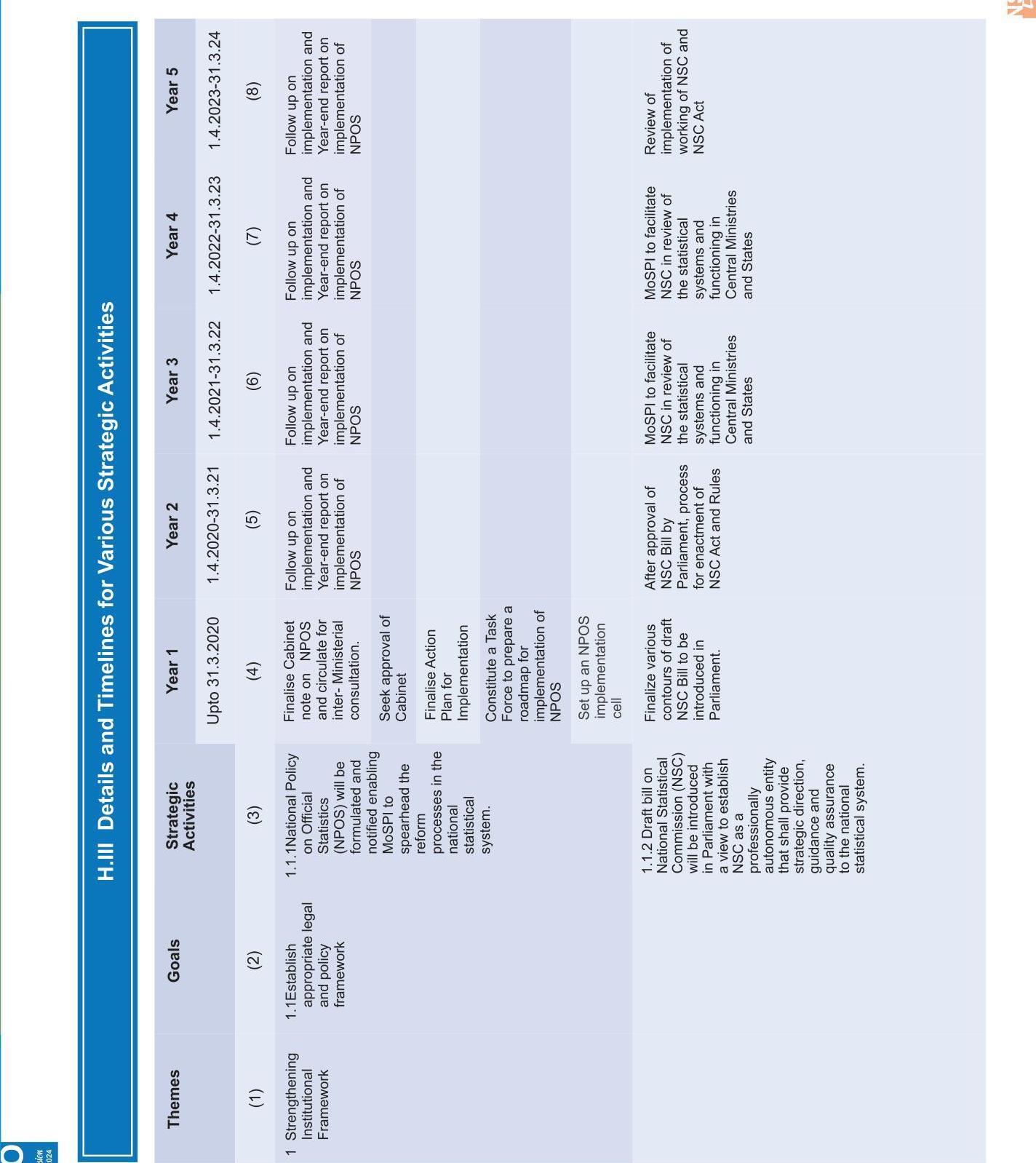
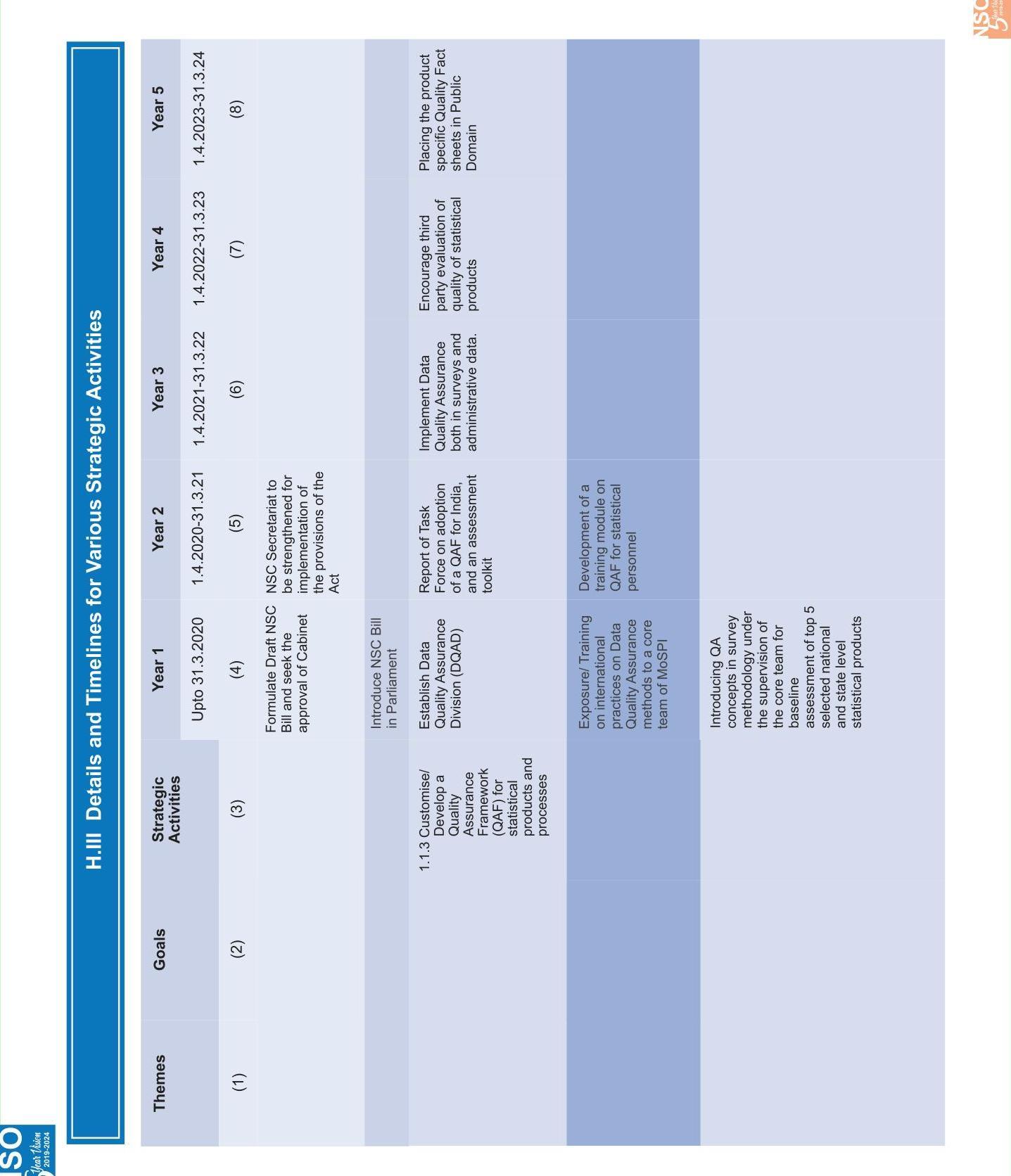
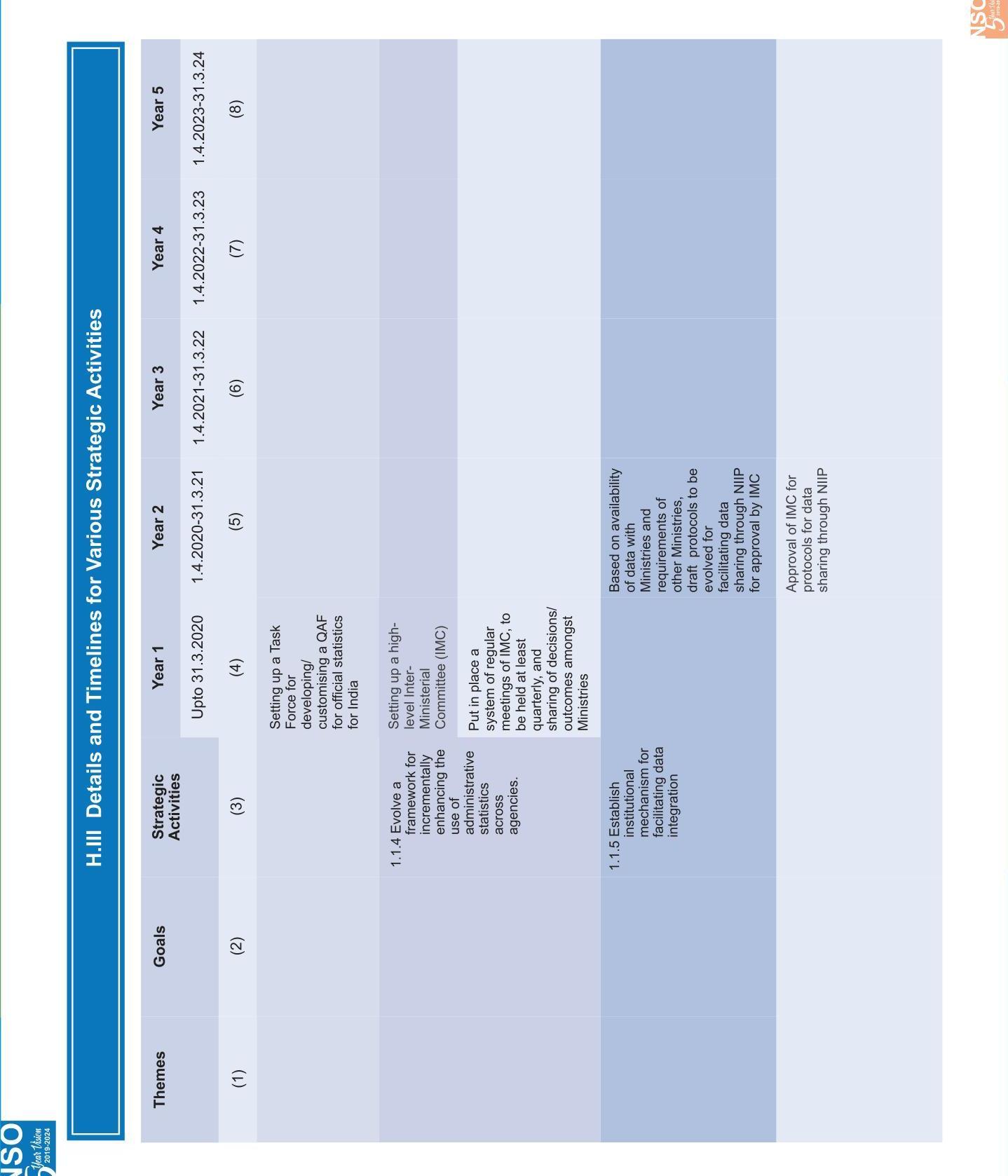

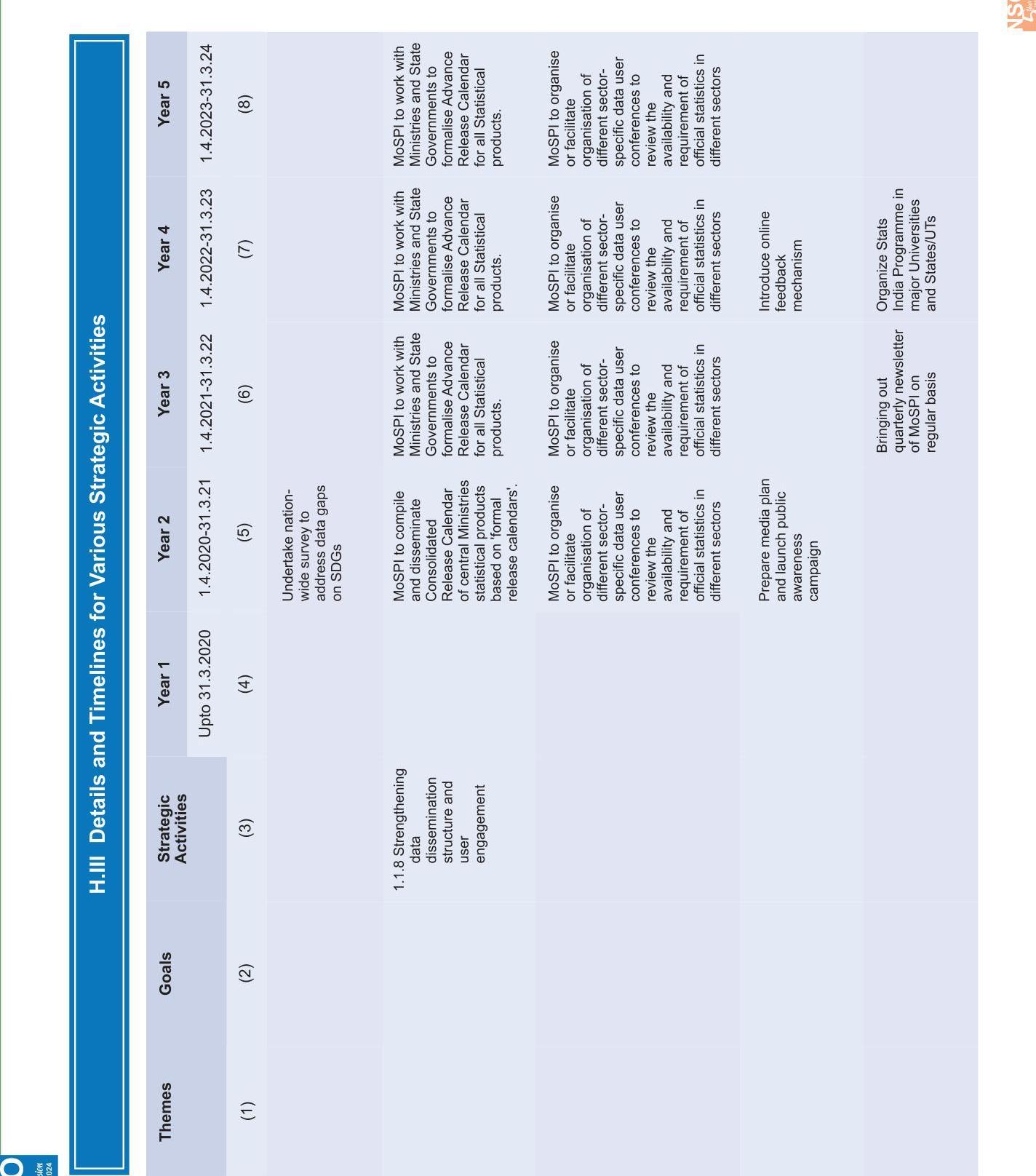
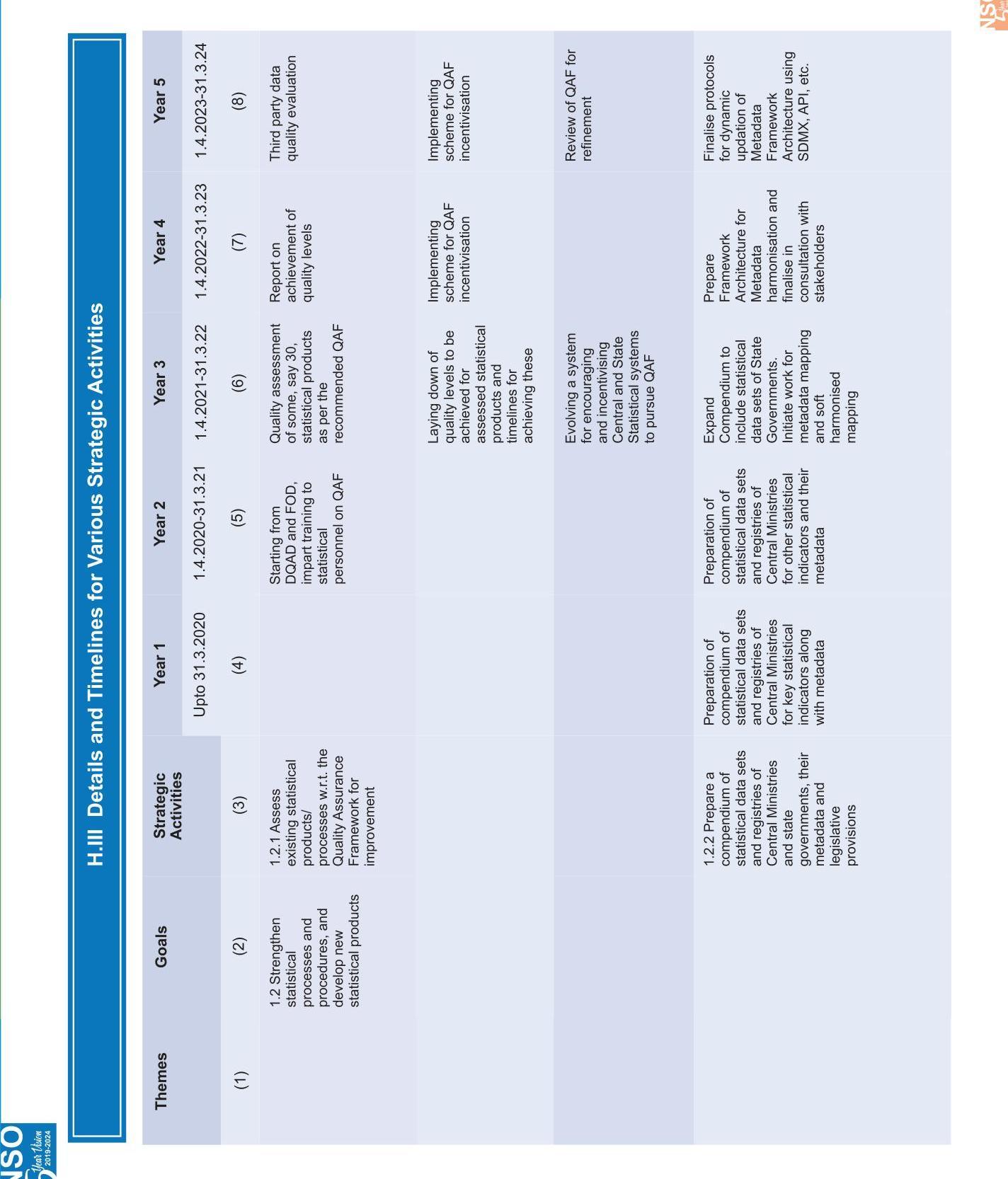
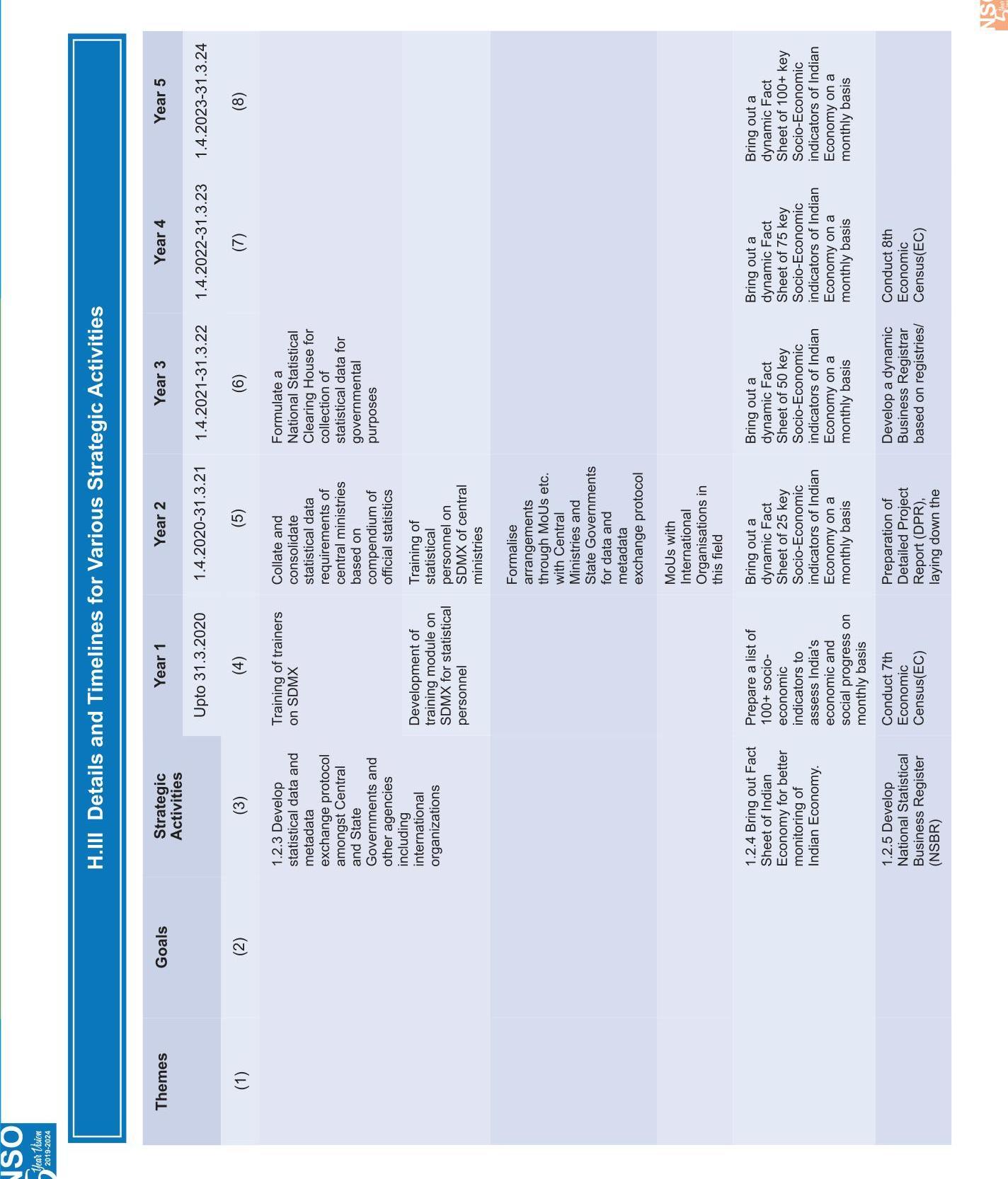
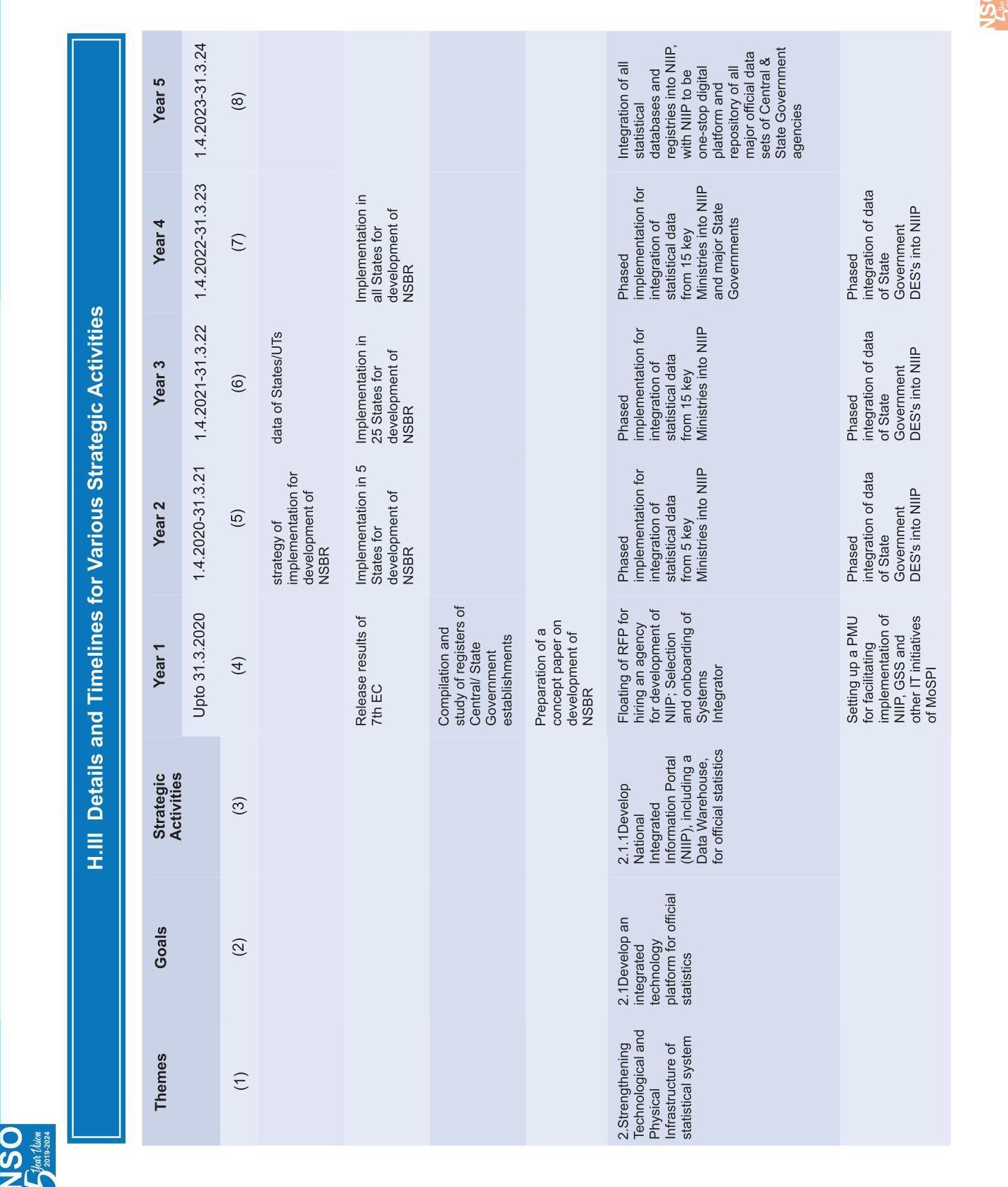
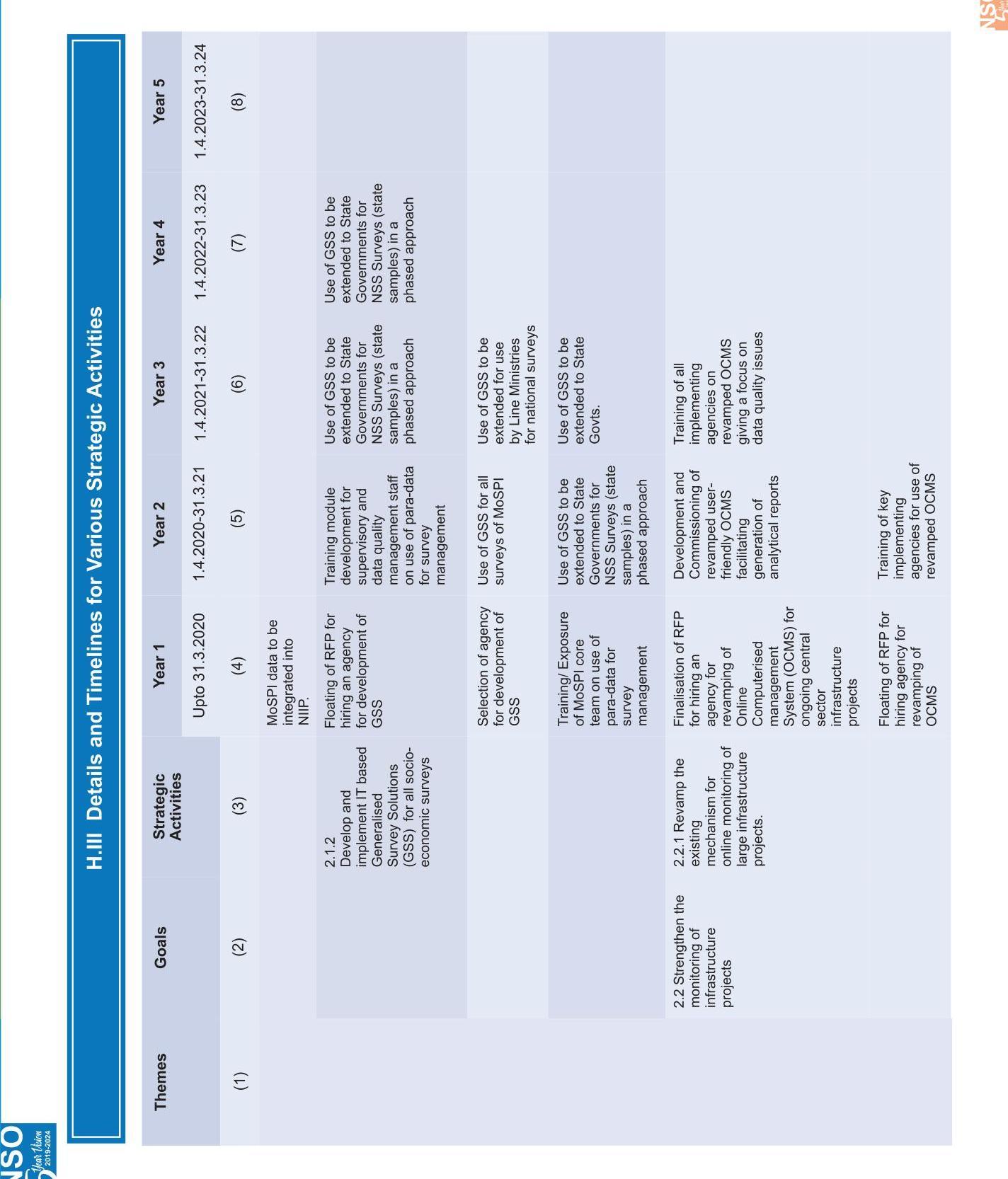
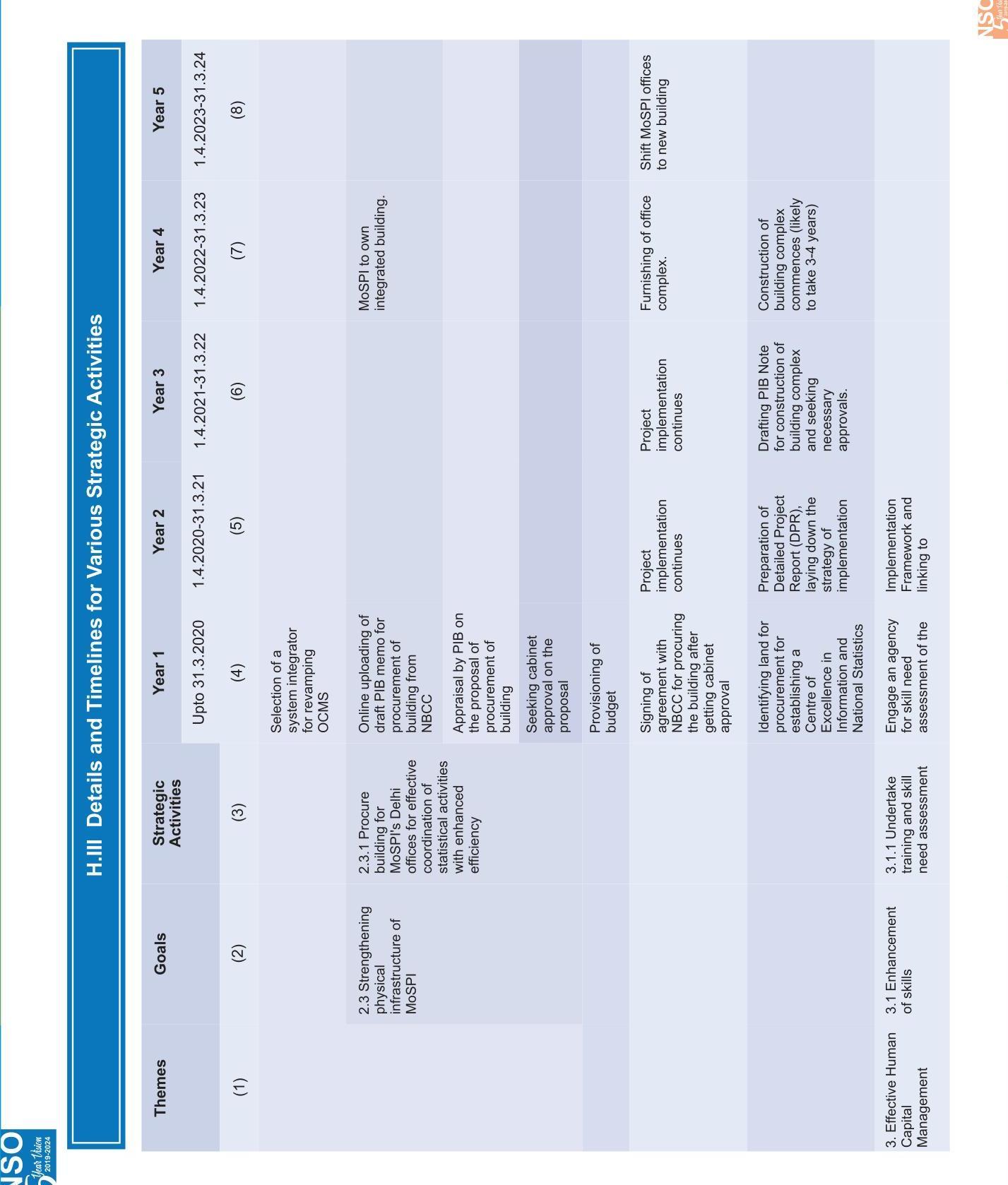
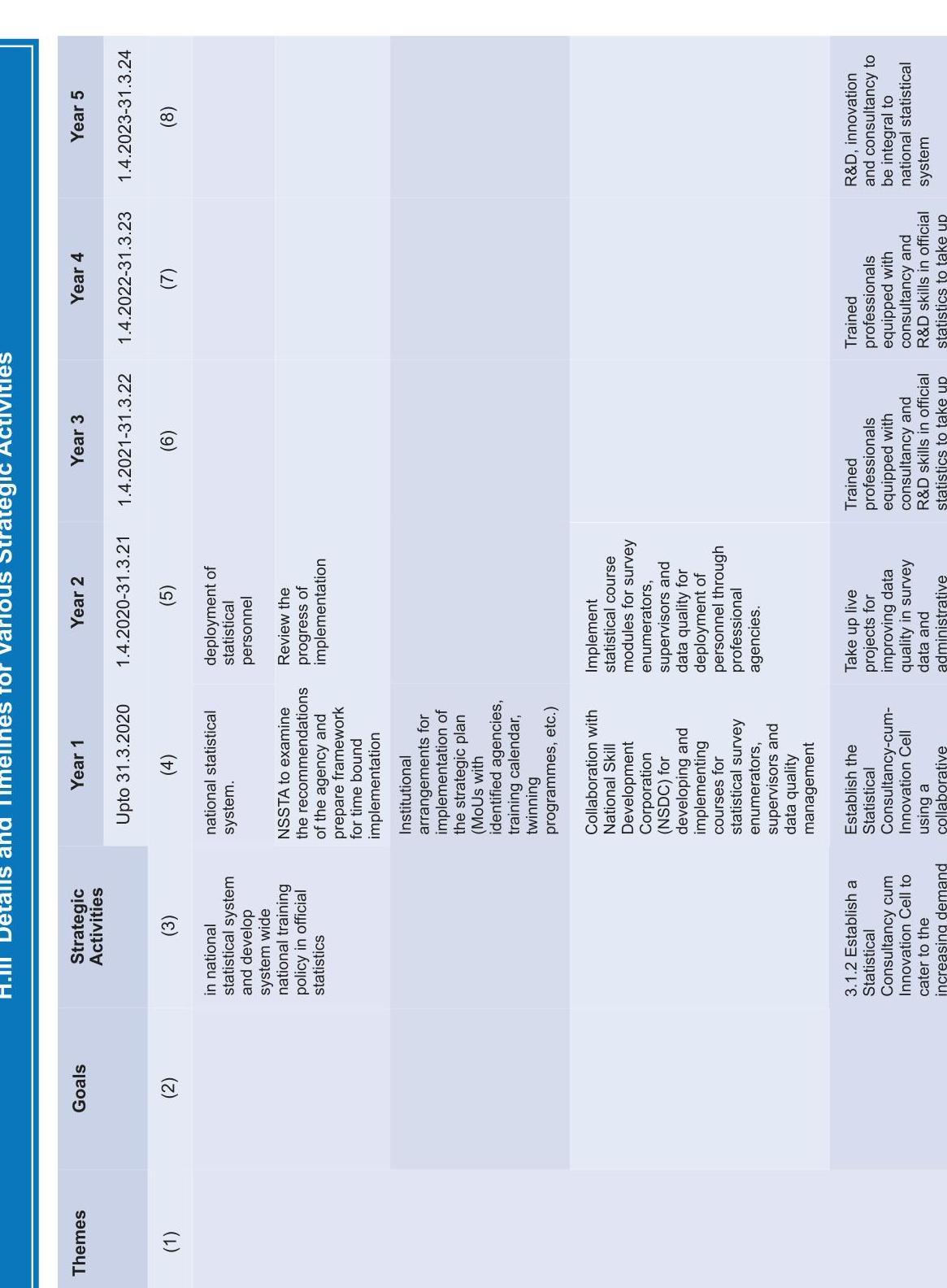
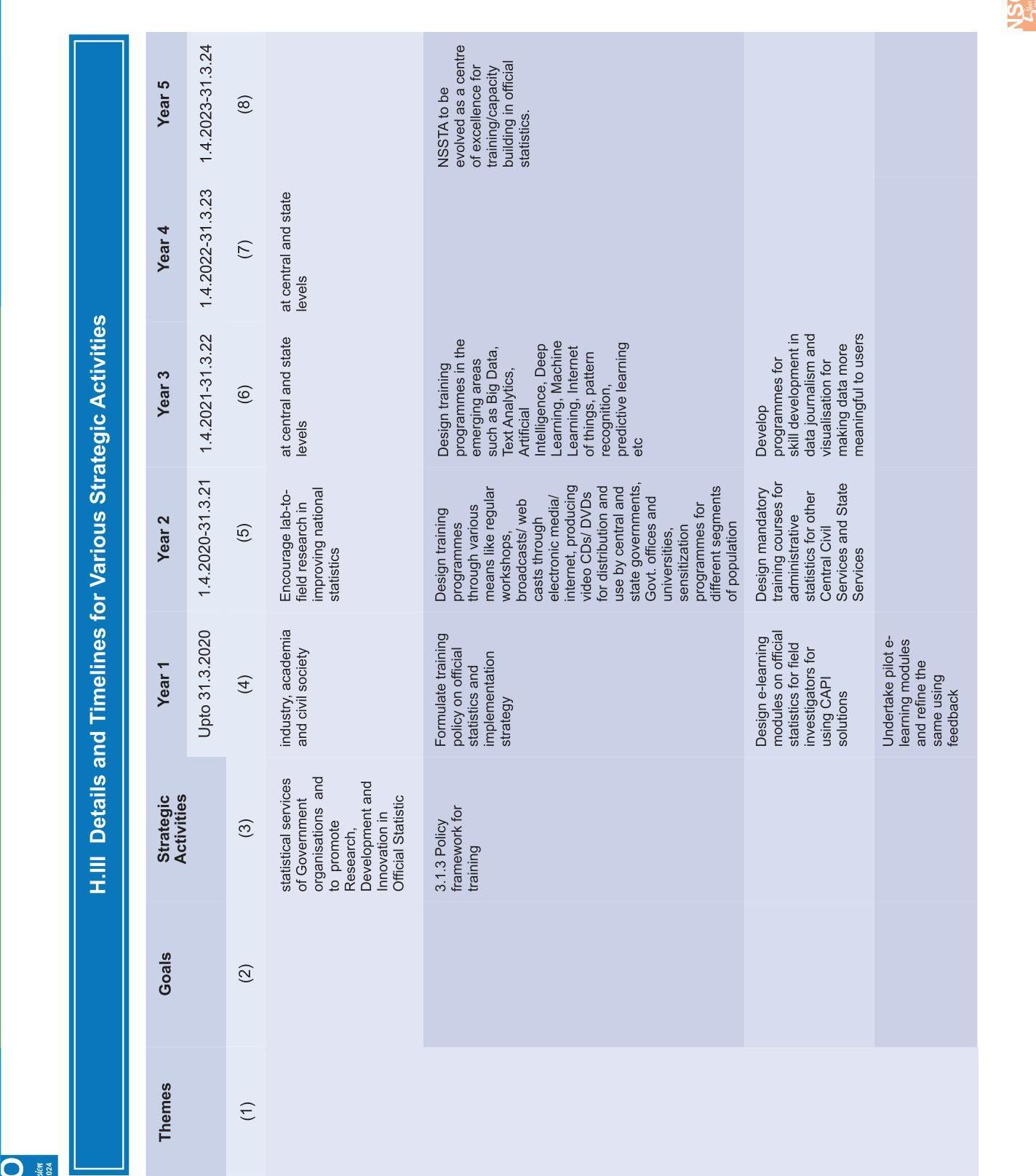
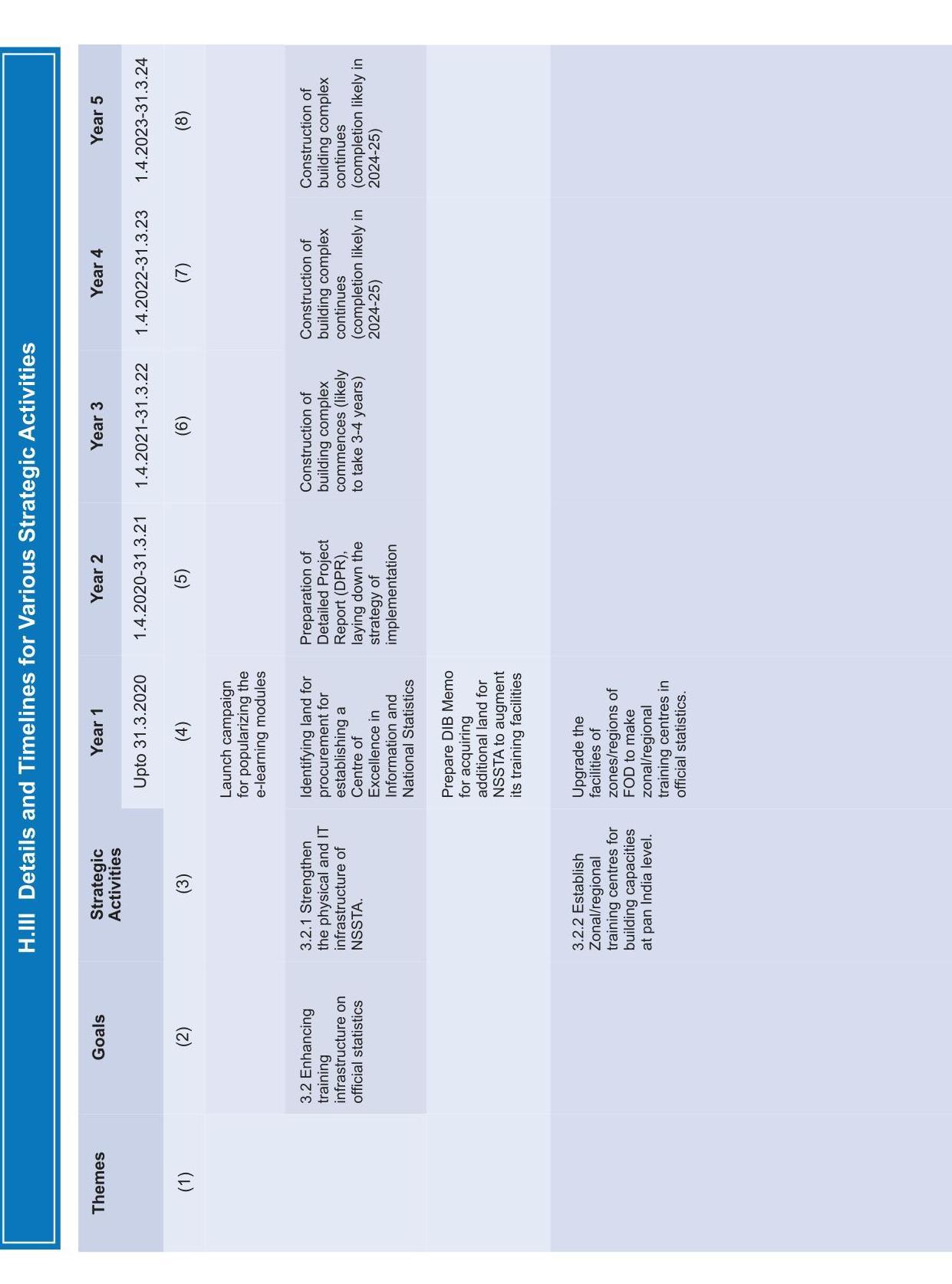
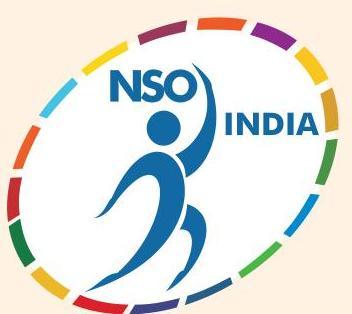
Data for Development

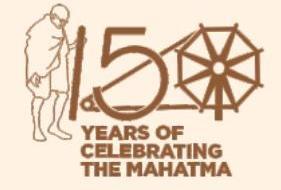


Data for Development
Government of India
Ministry of Statistics and Programme Implementation
Sardar Patel Bhawan,
New Delhi